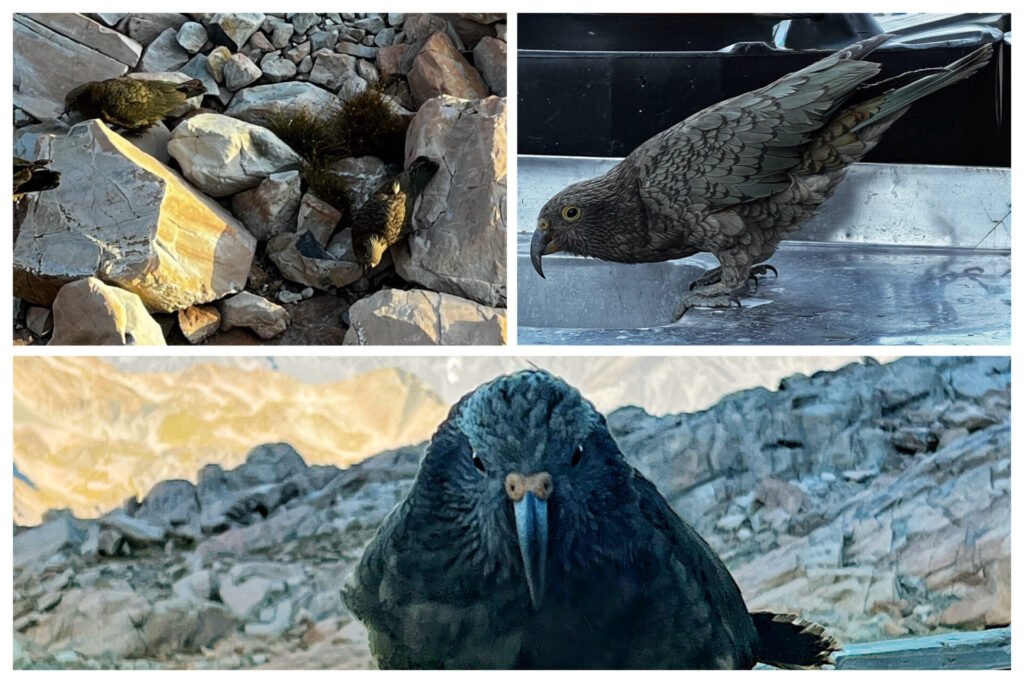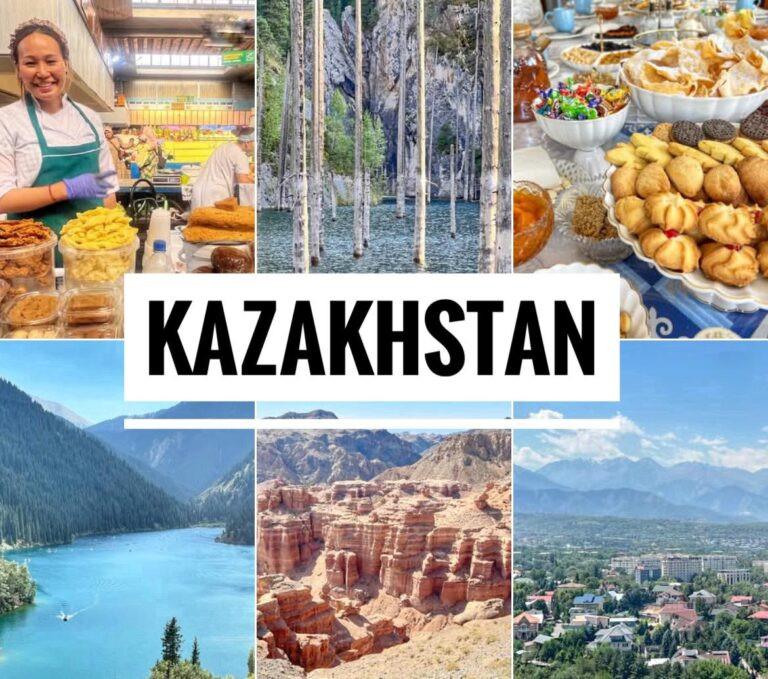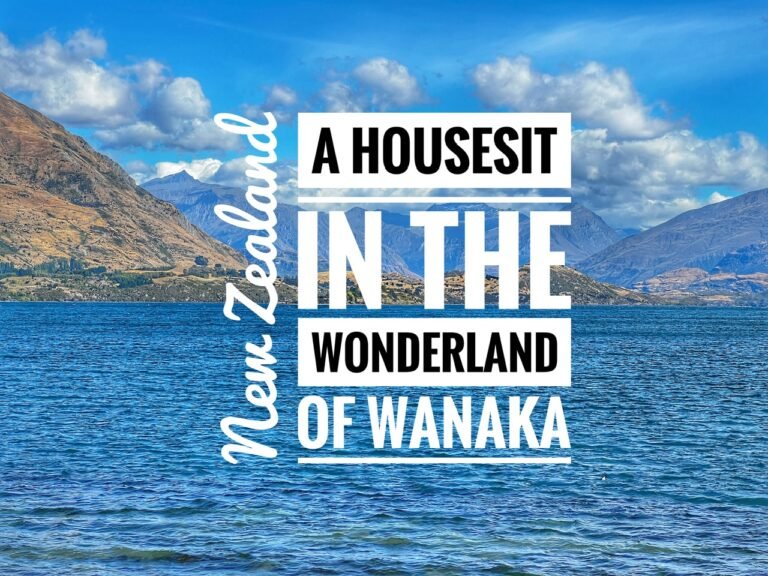
Doing the Hooker Valley Track gave us our first glimpse of the majestic Mt. Cook/Aoraki, but to truly soak in the beauty of New Zealand’s Southern Alps and the entire Aoraki/Mount Cook National Park, you have to climb a mountain. Perched 1,800 meters (5,900 ft) up nearby Mt. Ollivier lies one of the most incredible alpine huts in the entire country. The bright red Mueller Hut offers a truly epic panoramic view of Mount Cook—New Zealand’s tallest peak—and the surrounding alpine wilderness. And…it’s available for an overnight stay if you’re willing to put in the sweat equity to get there.
It’s no stroll in the park, though—the Mueller Hut hiking track is one of the most punishing alpine trails I’ve ever done. Only one of us chose to subject themselves to the self-abuse of traversing steep scree slopes and rock fields, while ascending 1,040 meters (3,340 ft) in just 4.6 km (2.85 mi). Mandy opted to enjoy the view from the campground instead.
Oh, and in addition to the stunning scenery, there’s also the chance to spot a kea—the world’s only alpine parrot.

A mountain vista that is truly astounding, and your reward!

Mount Cook/Aoraki in all its glory!
On the Trail

All packed up, and off I go! Bright blue skies and a georgous mountain hut await! Departing camp at about 1:30… hoping to arrive by dinner time to the hut. The Mueller Hut Track is a 5.2km, 4 hour hike from the White Horse Hill campground at the mountain base. The route is graded as “advanced” which in hindsight might be a wee bit understated… they must not have “stenuous” or “you’ll be crying mercy by the end” designation for trails in New Zealand. Well, no pain no gain!

After departing the campground, it was an easy 15 minutes on the trail before… you encounter what will be your nemesis for the next 2 hours. Stairs. Relentless, soul-sucking, stairstepping! A ridiculous 2,000(!!) larger than average steps, up the mountainside for two brutal hours!

About a quarter of the way up, you are rewarded with spectacular views of Mt. Cook, and (yesterdays hike) the Hooker Valley Track to the aquamarine Hooker lake. It looks like a gentle stroll compared to today’s hike.

Mueller Lake, is an otherworldly shade of glacial green, beneath the towering Mt. Cook/Aoraki.

Looking down into Mt. Cook Valley, a rest stop view after about 90 minutes of hiking. The campground is visible in the center foreground… the cars are already looking like ants as pangs of jealousy are beginning to well up inside me as I gasp to catch my breath, and think of Mandy chillaxing below… probably pouring herself a nice post nap glass of wine for happy hour.

At last, after a 550 meter ascent, a welcome repreieve and a chance to feel some sense of achievement that the stairs are done(!) Jaw-droppingly incredible views are everywhere you look of the valley below, and the glaciers are now eye-level at the Sealy Tarns lookout point. Most on the trail to this point turn around once they reach this pont, where the Mueller Hut extension heads where else… but straight up!
From this point, you are finished with the stairs, BUT they are replaced with an alpine boulder field where rock scrambling and monkey-crawling become common, as you carefully manuevour each step to avoid twisting your ankle in the hazardous rock fall terrain… it was extremely challenging! This is where you the grading of “advanced” begins to make sense. By the time you get through it you are begging for the stability of the stairs again!
The trail description at this point offers a thinnly veiled yet approriate warning, “Use Sealy Tarns as a decision point – check the weather, ensure your group are all feeling comfortable with continuing on to Mueller Hut, and make sure you have enough time to get there before dark. This is not a maintained track but an alpine route. Parts of the route are quite rocky as it zig-zags through alpine scrub, herb fields and tussocks to a large rock field. From here the route ascends a loose gravel slope (scree) of about 50 metres, to the skyline ridge.”

While in the campground the night before we had heard the loud booms and cracks that accompany the sounds of avalances on the mountain, but could not see the source. Until now. Caused by the calving of the glacier off the mountainside, these “Ice Fall Avalances” were on spectacular display on a warm sunny day… only completely visible once I had reached the saddle at the top of the ascent of the trail, at about 1,700 meters. It was an incredible show!

Good route finding awareness and having sure footing are essential skills on the upper portions of the Mueller Hut track. You are not following anything that looks like a trail at this point and staying on the trail becomes a matter of connecting the orange dots, how you get to each one is up to you. These orange marker stakes are spaced ~200 meters apart — make sure to keep an eye on the next marker stake before you lose sight of the last one. I would not want to do this hike in rain or foggy weather. These markers are the only indication you are on (or near) to the trail in the boulder fields…
At Mueller Hut

Isn’t she a beauty!! The Mueller Hut is like a bright red beacon, looking like an oasis mirage to the weary hiker, it sits almost impossibly anchored into a rocky face of Mt. Ollivier.
“Originally built in 1914, the present Mueller Hut is the fifth hut to be built with that name. The first hut was just 300 feet above the Mueller Glacier, but by 1947 it was 500 feet above the glacier and was deteriorating. A second hut lasted just four months until it was swept away by a wet-snow avalanche. Hut debris was hauled back up from the glacier and used to build temporary quarters erected at the same spot. The fourth Mueller Hut was built not far below the present site in 1953 and lasted until it was pulled down in 2003. The current Mueller Hut was opened in July 2003 by Sir Edmund Hillary, and is situated just below Mt Ollivier – the first mountain Sir Edmund climbed.” (The Department of Conservation)



It offers an incredible wrap around balcony with plenty of seating beaconing you to gawk at the views of the Mueller Glacier, Mount Sefton, and stunning Mt. Cook/Aoraki on the horizon. This vista from Mueller Hut, is truly an epic sight, making the pain to get here worth it.
I made my reservation 2 months ahead of time in order to secure a bunk in the Mueller Hut. A single “bunk” space costs $52 a night, and there are two large community sleeping rooms allowing 28 sleepers to occupy a space. You also get a locker for your stuff and a thin foam mattress pad to sleep on. You will be shoulder-to-shoulder with your neighbor which feels hostel-like, so ear plugs and a pillow are recommended if you value sleep. Other than that, the hut was plenty cozy despite temperatures dropping into the low 40’s F (6C) at night with the wind howling outside. Staying here was actually a great experience, made even better with a talk given by the hut host in the evening where we learned about the conservation efforts of the New Zeland department of Conservation to protect the native New Zealand birds like the remarkable kea.


Say hello to the resplendant kea, the only alpine parrot in the world, and a rare sight! This remarkably social, intelligent, and inquisitive bird actually lives in this barren and harsh alpine environment. Listed as endangered, there are estimates of only 1,000-5,000 left in the wilds of New Zealand’s South Island.

A group of about 8 Kea decended on the hut at about sunset, looking for scraps of food or trash to scavange. They are NOT shy birds, and will snatch food from you if you give them the opportunity to do so. Unfortunately, kea eating food from people has led to a massive problem for the birds, “When kea become habituated to human presence and are fed by people, they tend to forage at lower trophic levels and exhibit increased neophilia (attraction to new things). This behavior can lead them to interact more with human-made objects and environments, increasing their exposure to hazards such as lead poisoning, vehicle strikes, and ingestion of harmful substances.” Fortunately, though, we were warned to keep our food and trash out of their reach while at the hut.


Meaning we could instead focus on just saying hello, and getting an opportunity to watch in awe at these incredible and curious birds.

My dinner for the evening… about a 1,000 calories of freeze dried goop which we had picked up from the hostel in Queenstown in the “free” bin. The hut had a full kitchen with at least four gas cooking stations and gas was provided, which was slightly unfortunate considered I’d lugged my stove and propane up the mountain. Drinking water was also provided… all in all the hut makes it easy to hike here. Just bring your sleeping gear and meals. Unfortuanately, this free meal would wreak havoc on my gut in the middle of the night costing me a night of sleep when I really needed it.

The pit toilets… oddly being guarded by the local kea in the morning, I would spend most of my night becoming a bit too intimately familiar with their construction.

The absolutley breathtaking sunrise the next morning.

WOW, WOW, WOW!

And the uh, stellar views just keep coming… the clear skies during the night provided one of the most spectcular star viewing experiences. Mt. Cook/Aoraki sits within one of the “dark sky” regions of our planet, which can provide one of the best night sky views in the world.

I would like to say the descent was easier, but it was not, except, maybe that it was 60 minitues shorter…or, basically, the time I had spent resting on the ascent. This four-hour hike was one of the hardest I’ve ever done. I could not walk normally for a week afterwards. Incredibly, as I was departing the Mueller Hut at about 8am, I ran into a hiker who was just arriving, having started at 4(!), and was planning to make his return by 10am. Not sure that guy was entirely human though…?



